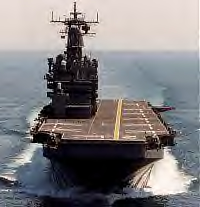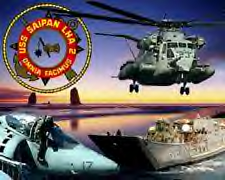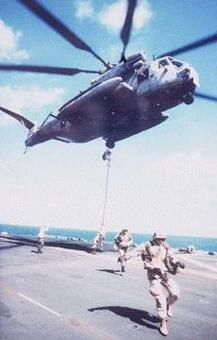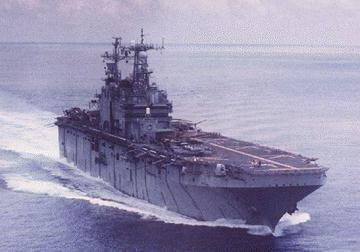


Welcome to the U.S.S. Saipan and AZC(AW/NAC) King's LHA Specific PQS questions and answers.
 This is the website for the 201 section of the LHA EAWS Specific PQS.
All of the questions were answered from instructions and directives found in NAVEDTRA, Personnel Qualification Standard (PQS), Enlisted Aviation Warfare Specialist (EAWS), Unit Specific for LHA.
This is the website for the 201 section of the LHA EAWS Specific PQS.
All of the questions were answered from instructions and directives found in NAVEDTRA, Personnel Qualification Standard (PQS), Enlisted Aviation Warfare Specialist (EAWS), Unit Specific for LHA.
All study information was provided by the EAWS Coordinators and Instructors on board the mighty U.S.S. Saipan.
LAST UPDATED:14 May 2004

201: AIR DEPARTMENT SYSTEMS
201.1 SYSTEM COMPONENTS AND COMPONENT PARTS
Referring to a standard illustration of this system or the actual equipment, identify and discuss the following system and system components.
201.1.1 Primary Flight Control (PRI-FLY):
personnel:
Responsible to the Commanding Officer for all aircraft handling, launching, recovering, V.L.A. and servicing. Responsible for visual control of all aircraft operating in control zones (5NM radius, surface to 2,500’).
Assist AIR BOSS with his/her responsibilities/duties, and functions as departmental training coordinator.
b. Identify the stations manned during PRI-FLY.
Flight deck control, V-4 fuels control, Hanger deck control, Combat cargo, Medical BDS, ASE, Engineering (elevator rooms), Ops.
201.1.2 Aircraft handling/crash and salvage:
a. Identify the stations manned in flight deck control.
Aircraft handling officer, WeeGee board operator, phone talker, fuels phone talker, combat cargo, squadron maintenance representative, and ordnance representative.
b. State the duties and responsibilities of the Aircraft
Handling Officer.
Make sure all operations on flight/hanger deck are done safely and effectively.
Responsible for flight deck fire fighting, rescue, clearing flight deck crashes, and maintaining all crash and fire fighting equipment.
d. Discuss the duties and responsibilities of the following:
1. Crash and Salvage Officer (ie. Air Boss)
For the organization, supervision and training of aircraft crash and salvage team.
2. Flight Deck Supervisor.
Assists the flight deck officer in aircraft movement in
preparation for launch, recovery and re-spot evaluations. Readiness of flight deck personnel, equipment (fire fighting), salvage.
3. Landing Signal Enlisted (LSE).
Responsible for the safe launch/recovery of helicopters.
4. Vertical Short Take-off and Landing Launch Officer (ie AV-8 Launch Officer).
Responsible for the safe launch/recovery of AV-8 aircraft.
201.1.3 Aircraft launch/recovery equipment:
a. Discuss the purpose of the following flight deck lights/equipment:
Red flashing (foul deck)
Green (ready deck)
Amber (standby launch and recovery)
Blue (HERO)
2. Vertical Short Take-off and Landing (V/STOL)
Training/STOL (white)
FWD port, port, stab, athwart ship edge lighting, (white)
Safe parking (red)
Vertical dropline lights (red)
3. Hover Position Indicator (HPI)
Optical landing aid
4. Wave-off Cut Light system
Optical landing aid
201.1.4 Identify the stations manned in hangar deck control.
Spotting board operator, phone talker, elevators, conflag stations.
201.1.5 Briefly describe the organization of the aviation fuels division.
Three separate parts of V-4; 1 – below decks, 2 – flight deck, 3 – Quality Assurance.
201.1.6 Briefly discuss the purpose of the following equipment as applies to the JP-5 Quality Surveillance Program:
a. Combine Contaminated Fuel Detector (CCFD)
Tests fuel for sediment and water.
b. Flash point tester
Test fuel for flash point.
c. Fuel System Icing Inhibitor (FSII) test kit
Tests fuel for an additive used and designed for fuel to keep any water caused by condensation from from freezing.
201.2 PRINCIPLES OF OPERATION – None to be discussed.
201.3 PARAMETERS/OPERATING LIMITS – None to be discussed.
201.4 SYSTEM INTERFACE – None to be discussed.
201.5 SAFETY PRECAUTIONS
201.5.1 Discuss the three causes of nearly all aircraft handling mishaps/incidents.
201.5.2 Discuss general safety precautions that must be observed during launch/recovery operations.
Only authorized personnel on deck, in catwalks, and on elevators during launch and recovery operations.
201.5.3 Discuss general safety precautions that must be observed during fueling/defueling.
Ensure the aircraft and fueling station are properly grounded, fuel hoses are in good repair and not obstructed, sufficient fire fighting equipment is within reasonable distance.
201.5.4 Discuss the importance of raising and lowering the ship’s antennas.
Antennas shall be de-energized prior to lowering/raising.
kimberly.a.king@navy.mil
AZC(AW/NAC) Kimberly King
